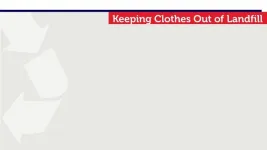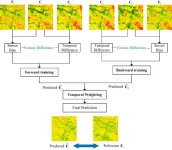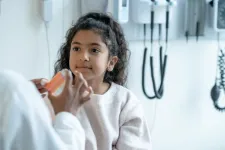(Press-News.org) The first-ever nationwide study into how Australians use and dispose of clothing has revealed people are buying too many clothes and are unsure how to discard them responsibly.
Conducted by RMIT University and commissioned by the Kmart Group and the Queensland Government, a study of 3,080 Australians explored how they acquired, used and disposed of their clothing.
Australians are among the world’s biggest clothing consumers, importing 1.4 billion units or over 383,000 tonnes annually.
But each year, more than 200,000 tonnes of clothing is sent to landfill.
The authors recommend establishing a national textile collection program for unwearable clothing that could be recycled, to prevent items being unnecessarily sent to landfill.
Across all findings, age was the most significant factor in determining consumer clothing practices, surpassing gender, income bracket and location.
Young Australians, aged 18–34, were more likely to buy second-hand, repair, resell or share clothes but tended to have large collections of unused clothing that were no longer in style.
Older Australians were more likely to donate clothing they no longer wanted, though were less likely to buy second-hand.
Lead author RMIT Professor Alice Payne said although Australians buy too many clothes, there are some things we do well.
“Compared to European data, Australians are better at shopping second-hand and washing clothes responsibly,” said Payne, Dean of RMIT’s School of Fashion and Textiles.
"Brands and retailers must create higher-quality products that endure both fashion trends and wear."
Happy to donate but confused about responsible disposal
Most Australians donate unwanted but otherwise good clothes, with 87% of consumers indicating they donate unwanted clothing to charity.
The findings also show consumers are confused about where and how to responsibly discard clothing that can no longer be worn.
Fifty-one per cent throw away worn-out or significantly damaged clothes in the general waste bin and 30% in the household recycle bin at least half of the time.
Payne said consumers need more durable products and a national textile recycling scheme, which were key recommendations in the report.
“Our research found consumers clear out their wardrobes once or twice a year, and strategically timed collection drives for this clothing could work well,” she said.
Kmart Group’s Head of Sustainability, Blake Lindley, said the findings speak to the company’s commitment to a sustainable textiles industry.
“This landmark study provides us with the vital data we need in order to develop and invest in evidence-based programs and initiatives that will directly and measurably reduce the amount of clothing that ends up in landfill,” he said.
“We know our customers want to do the right thing.
“As one of Australia’s largest retailers we have an important role to play; we’re committed to developing and being part of the right solutions that have a material impact on fashion waste.”
Second-hand sellers deserve government help
Co-author Professor Simon Pervan from RMIT’s Graduate School of Business and Law said governments could step in by supporting second-hand clothing sellers.
“Businesses who resell clothing should be financially supported through grants, investments or financial incentives,” he said.
“These circular business models exist in the market but need a helping hand to scale up and boost capacity.”
Consider repairing your clothes
About one in three consumers preferred to repair clothing themselves or take it to a professional repairer, particularly if they had paid a higher price or felt emotionally attached.
Payne said Australians were open to repairing their clothes but often did not know how.
“We need clothing education programs, focused on boosting Australians’ clothing repair skills and confidence,” she said.
“This could be through supporting initiatives such as community repair cafes and embedding skills into school curriculums.”
Next steps
Payne said while textile recycling options were currently limited, there were still things we can do.
“Buying fewer new clothes and keeping them in use for as long as possible will go a long way,” she said.
“Try to use unwearable clothes around the house as rags or repurpose in other ways, and when the time comes, dispose of them responsibly by sending for recycling.”
The study also identified three types of Australian personas with respect to their clothing practices, which can help industry and government engage with consumers.
Kmart Group has committed to funding at least two more national surveys to run in 2027 and 2031, which will measure the country’s progress towards clothing circularity.
Read the report, Keeping clothes out of landfill: A landscape study of Australian consumer practices, which was funded jointly by Kmart Group and the Queensland Government Department of Environment, Science and Innovation. DOI: 10.25439/rmt.27092239
Co-authors: Alice Payne, Xinru (Angie) Jiang, Paige Street, Mark Leenders, Ninh Nguyen, Simon Pervan, Carol Tan
END
Age trumps gender, income and postcode for consumers' clothing habits
The first-ever nationwide study into how Australians use and dispose of clothing has revealed people are buying too many clothes and are unsure how to discard them responsibly
2024-10-01
ELSE PRESS RELEASES FROM THIS DATE:
Researchers develop method to obtain fine spatial and temporal resolution land surface temperature data
2024-10-01
Scientists need fine spatial and temporal resolution land surface temperature (LST) data for many types of research and applications. Spatio-temporal fusion, a technique that combines data from multiple sources to create high-resolution images with both spatial (space) and temporal (time) details, is an important solution for researchers needing fine spatio-temporal resolution LST data. A team of researchers propose a new spatio-temporal fusion method based on Restormer (RES-STF).
Their work is published in the Journal of Remote Sensing on August 21, 2024.
LST data, the measurement ...
Feet first: AI reveals how infants connect with their world
2024-10-01
Recent advances in computing and artificial intelligence, along with insights into infant learning, suggest that machine and deep learning techniques can help us study how infants transition from random exploratory movements to purposeful actions. Most research has focused on babies’ spontaneous movements, distinguishing between fidgety and non-fidgety behaviors.
While early movements may seem chaotic, they reveal meaningful patterns as infants interact with their environment. However, we still lack understanding of how infants intentionally engage with their surroundings and the principles guiding their ...
Addressing health equity in childhood asthma requires engaging affected communities
2024-10-01
NEW YORK, NY (Oct. 1, 2024) – Systemic racism remains a significant challenge in efforts to address health disparities in childhood asthma. A new American Thoracic Society report provides practical frameworks to begin the research necessary to make real progress in treating asthma in Black and Latino children, who are more likely than their white counterparts to report to emergency rooms in the U.S.
Stephanie Lovinsky-Desir, MD, and a diverse group of researchers, clinicians, social scientists and community health workers shared their findings in the report published online this week in ...
Light-based microcapillary monitoring sparks innovation in manufacturing and biotechnology
2024-10-01
Dr. Jaeyeon Pyo of the Smart 3D Printing Research Team at the Korea Electrotechnology Research Institute (KERI) has developed a breakthrough technology that uses light to visualize nanoscale glass microcapillary tips, enabling precise and delicate contact with other objects.
A “‘Microcapillary” is a precision tool with a very small aperture (0.1 mm to 0.000010 mm in diameter) fabricated from a glass tube. It is utilized as a vital tool in various fields, from biotechnology to manipulate cells, to micro electroplating and nano 3D printing. Specifically, it is used in biotechnology faor tasks such as injecting sperm into an egg during in vitro fertilization (IVF) ...
Global effort to map the human brain releases first data
2024-10-01
Seattle, WA – October 1, 2024 – The BRAIN Initiative® Cell Atlas Network (BICAN) has launched its first major data release, marking a significant milestone in the ambitious effort to map the whole human brain.
The data, accessible through the BICAN Rapid Release Inventory, includes single-cell and single-nucleus transcriptomic and epigenomic profiles from humans, mice, and 10 other mammalian species. Sourced from multiple grants and labs within the consortium, including the Allen Institute, these data are from projects that aim to identify and define brain cell types based on molecular profiles.
“The ...
Scientists discover planet orbiting closest single star to our Sun
2024-10-01
Using the European Southern Observatory’s Very Large Telescope (ESO’s VLT), astronomers have discovered an exoplanet orbiting Barnard’s star, the closest single star to our Sun. On this newly discovered exoplanet, which has at least half the mass of Venus, a year lasts just over three Earth days. The team’s observations also hint at the existence of three more exoplanet candidates, in various orbits around the star.
Located just six light-years away, Barnard’s star is the second-closest stellar system — after Alpha Centauri’s three-star group — and the closest individual star to us. Owing to its proximity, it is a primary target in ...
New ACS report: Breast cancer mortality continues three decade decline overall, but steeper increases in incidence for women
2024-10-01
The American Cancer Society (ACS) today released Breast Cancer Statistics, 2024, the organization’s biennial update on breast cancer occurrence and trends in the United States. The new report finds breast cancer mortality rates overall have dropped by 44% since 1989, averting approximately 517,900 breast cancer deaths. However, not all women have benefited from this progress, notably American Indian and Alaska Native (AIAN) women, whose rates have remained unchanged over the past three decades. Also concerning ...
Immigrants to the United States still assimilate
2024-10-01
Children of immigrants to the United States typically incorporate themselves into US economic and cultural life, and this pattern of assimilation has not markedly changed in over a century. Today, one in seven US residents was born abroad, rates similar to those seen in the late nineteenth century. As immigrants’ countries of origin have shifted from Europe to Asia and the Americas, a narrative has developed that contemporary immigrants do not assimilate as thoroughly as older immigrants. But is this true? In a Perspective, Ran Abramitzky and Leah Boustan summarize their long-running research program matching individuals across historical US Censuses. The authors compare ...
Vaccinating the young to save the old in the Tropics
2024-10-01
A model suggests that vaccinating children and teens against the flu can help protect the elderly in tropical countries. Influenza kills up to 650,000 people worldwide every year. In part due to the lack of strong seasonality and differences in vaccine supply, optimal vaccination strategies for the tropics may differ from those in temperate zones. Joseph Servadio and colleagues parameterized an age-structured mathematical model of influenza transmission to the asynchronous, non-annual epidemiology of tropical influenza in Vietnam, a country with low vaccine coverage. The model includes three subtypes of the flu virus. Vaccinating year-round was found to be ...
Climate change, drought, dust, and plankton blooms
2024-10-01
A study links an unusual plankton bloom off the coast of Madagascar to drought in Southern Africa. Climate warming has intensified droughts around the world. When vegetation dies from lack of water, the wind can pick up and carry unprotected soil particles for thousands of kilometers. These dust particles can then act as fertilizer when deposited in seawater. Dionysios Raitsos and colleagues show that dust from drought-stricken Southern Africa caused a bloom of marine phytoplankton off the southeast Madagascar coast from November 2019 through February 2020. The team used standardized anomalies of dust aerosol optical depth from the Copernicus ...
LAST 30 PRESS RELEASES:
School meals could unlock major gains for human and planetary health
Menopause hormone therapy does not appear to impact dementia risk
Signature patterns of brain activity may help predict recovery from traumatic brain injury
Dresden study uncovers new key mechanism in cancer cells
New species are now being discovered faster than ever before, study suggests
Cannabis-based products show limited short-term benefit for chronic pain, with increased risk of adverse effects
Cannabis products with more THC slightly reduce pain but cause more side effects
Clearing the brain of aging cells could aid epilepsy and reduce seizures
Brain injuries linked with potential risk of suicide, new study finds
New technique lights up where drugs go in the body, cell by cell
New study finds movement of fishing fleets can reveal shifts in marine ecosystems
Embargoed: New evidence points to potential treatment for vascular dementia
Study uncovers disrupted brain balance in alcohol dependence
Working in groups can help Republicans and Democrats agree on controversial content moderation online
Structural findings reveal how distinct GPCR ligands create different levels of activation
Anything-goes “anyons” may be at the root of surprising quantum experiments
UC review: Maximizing workplace opportunity for veterans
From generation to complex control: Metasurfaces make perfect vortex beams "within reach"
Thin-film lithium niobate-based detector: recent advances and perspectives
Exploring why some people may tend to persistently make bad choices
How cells balance their protein levels
Nirsevimab vs RSVpreF vaccine for RSV–related hospitalization in newborns
Effectiveness and impact of maternal RSV immunization and nirsevimab on medically attended RSV in US children
AI gives scientists a boost, but at the cost of too many mediocre papers
Next-generation vision model maps tree growth at sub-meter precision
Genes aren’t destiny for inherited blindness, study shows
MIT study: High-fat diets make liver cells more likely to become cancerous
Exposure to multiple fine particulate matter components and incident depression in the US Medicare population
Risk of burdensome health care spending over time in the US
Nirsevimab against hospitalizations and emergency department visits for lower respiratory tract infection in infants
[Press-News.org] Age trumps gender, income and postcode for consumers' clothing habitsThe first-ever nationwide study into how Australians use and dispose of clothing has revealed people are buying too many clothes and are unsure how to discard them responsibly









